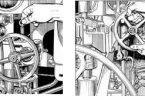- Bridge team( Command Team)
- Emergency team 1 ( In charge chief officer.)
- Emergency team 2 (In charge second engineer)
- Support team (service team.)
- Technical team ( In charge chief engineer).
The plans should be directed at achieving the following aims:
- Rescue and treatment of casualties
- Safeguarding others
- Minimising damage to property and the environment
- Bringing the incident under control.
The plans should include advice on the following:
- Fire
- Collision
- Grounding
- Cargo spillage/leak
- Personnel casualty
Your ship has contingency plans you must be familiar with them and the equipment you may have to use
Following a marine incident or accident involving collision, spill of oil, fire, injury to personnel or worse, the Master, the bridge team and all the crew are in a very stressful and time sensitive environment. Today’s contingency plans require a huge volume of reporting and regulatory response. As most incidents occur close to the shore, where all vessels are at their most vulnerable, within minutes of an accident a variety of interested parties will be requiring the time and that of senior officers onboard.
Below is the list of various shipboard emergency and contingency plans:
- Abandonship procedures – Immediate Evacuation By Own Survival Craft
- Grounding accident and immediate action
- Collision accident – Emergency procedure
- Action in case of Man Overboard
- Action before entering fog
- Action in case of gyro failure / compass failure
- Action in case of Main Engine Failure
- Tackling fire – Emergency procedure
- Emergency Procedures for rescue – a guide to salvage operation
- Assist Vessel in Distress/Towing of Vessel in Distress
- Leaks on the Cargo System, Continuous Flow – how to prevent
- Leaks and immediate action
- Leaks from a Loading Arm due to Tidal or Current Effects
- Compressed air system – Gas carrier immediate actions
- Risk of Overfilling of Cargo Tank during Loading
- Cargo tank ruptures due to increased pressure – emergency procedure for gas carriers
- Loss of power supplies – emergency actions
- Risk and hazards of Equipment failure
- Loss of Instrumentation during Unloading Operations – Recommended actions by Liquefied Gas carriers
- Risk and hazards of Nitrogen Loss
- Gas carriers Loss of Instrumentation during Loading Operations
- Gas carriers Structural Damage due to Incorrect Loading/Unloading Sequence


